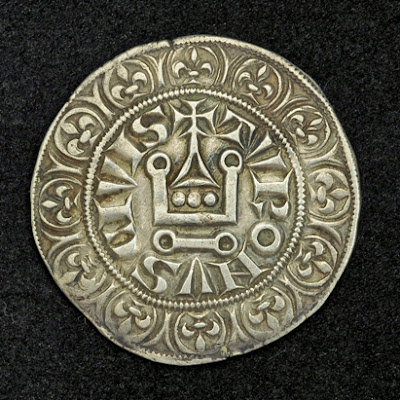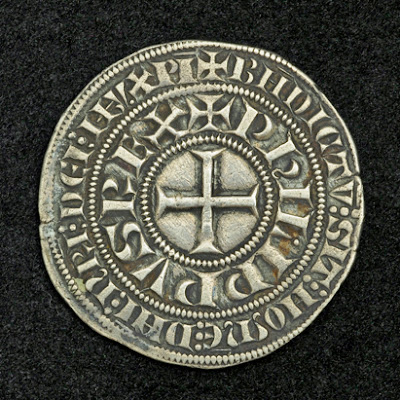 |
| Coins of medieval Europe - Gros Turnois |
 |
| Gros Tournois - Medieval European Coinage |
Royal France Gros Tournois Silver coin of 1290, Philip IV "the Fair".
French coins, French Royal and Medieval Coins, collection French Royal coins, Coins of Medieval Europe, French Royal Coinages, Medieval Money and Coins, Medieval European Coins, Collecting the Coins of France.Obverse: Stylized castle (châtel tournois), topped by a cross. All within floral border of twelve embedded lis.
Legend: +TVRONVS CIVIS
Reverse: Cross pattée within inner circle.
Inner Legend: +PhILIPPVS REX
Outer Legend: +BHDICTV SIT HOME DHI nRI DEI IhV .XPI
The image on the obverse side of the coin known as the châtel tournois - has traditionally been assumed to be a representation of the abbey church of St Martin or possibly the town gate of Tours, but following the style of the church found on Carolingian deniers. However, one French numismatist contends that the image is in fact of the reliquary of St Martin at Tours.
The inscription on the reverse says BENEDICTV SIT NOME DNI NRI IHV XPI, which is benedictum sit nomen domini nostri Jesu Christi or “blessed is the name of Our Lord Jesus Christ”, and LVDOVICVS REX which is Ludovicus Rex or Louis, King.
The inscription on the obverse says TVRONVS CIVIS or Turonus Civis, City of Tours.
Mint Year: 1285-1290
References: Duplessy 213, Ciani 201. R
Diameter: 25 mm; Weight: 4.08 gram of Silver.
Gros Tournois of France - Large silver coin first struck by Louis IX as the foundation his great monetary reform of 15 august 1266, started the wide spread of the new coin across the European continent. According to the Italian example the city of Tour released a new coin of 958 standards that was made out of twelve denarius (denier), weighed 4.22 grams. The new coin received its name due to the mintage place and was called «gros tournois» or turnos. Very quickly, this coin gained recognition in France and abroad, and became not only a model for direct copying and imitation in the coinage of other states, but also was used in the international trade as a generally accepted means of payment in medieval Europe.
Philip IV (French: Philippe le Bel, April–June 1268 – 29 November 1314), called the Fair, was King of France from 1285 until his death. He was the husband of Joan I of Navarre, by virtue of which he was, as Philip I, King of Navarre and Count of Champagne from 1284 to 1305.